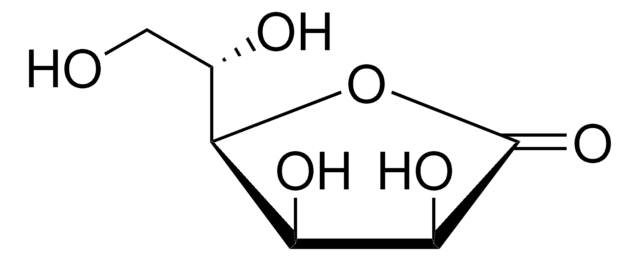05313
L-Galactono-1,4-lactone
≥95.0% (GC)
Synonym(s):
L-Galactonic acid γ-lactone, NSC 25282
About This Item
Recommended Products
Quality Level
assay
≥95.0% (GC)
form
solid
optical activity
[α]/D 78.0±3.0°, c = 1 in H2O
color
white
mp
134 °C ((273 °F))
suitability
conforms to structure for Proton NMR spectrum
storage temp.
−20°C
SMILES string
OC[C@H](O)[C@H]1OC(=O)[C@@H](O)[C@@H]1O
InChI
1S/C6H10O6/c7-1-2(8)5-3(9)4(10)6(11)12-5/h2-5,7-10H,1H2/t2-,3-,4-,5+/m0/s1
InChI key
SXZYCXMUPBBULW-NEEWWZBLSA-N
Looking for similar products? Visit Product Comparison Guide
Biochem/physiol Actions
Other Notes
Storage Class
11 - Combustible Solids
wgk_germany
WGK 3
flash_point_f
Not applicable
flash_point_c
Not applicable
Certificates of Analysis (COA)
Search for Certificates of Analysis (COA) by entering the products Lot/Batch Number. Lot and Batch Numbers can be found on a product’s label following the words ‘Lot’ or ‘Batch’.
Already Own This Product?
Find documentation for the products that you have recently purchased in the Document Library.
Our team of scientists has experience in all areas of research including Life Science, Material Science, Chemical Synthesis, Chromatography, Analytical and many others.
Contact Technical Service








